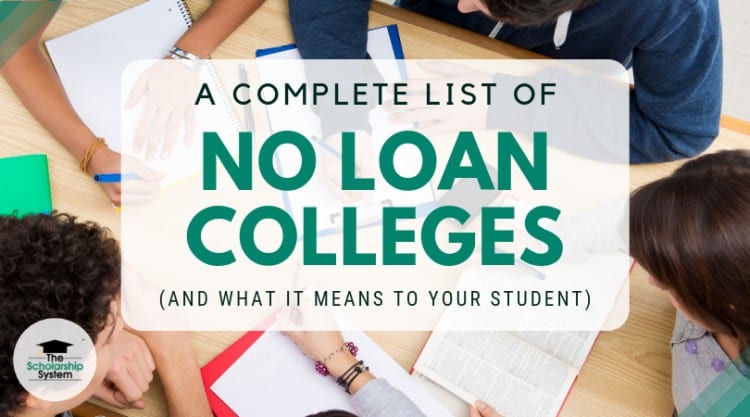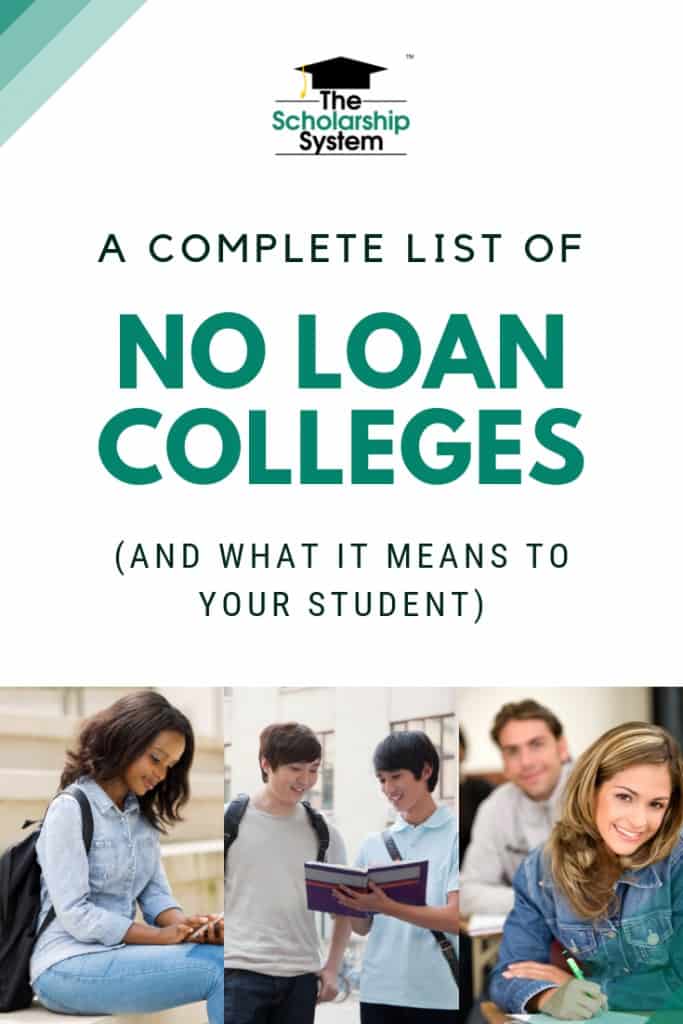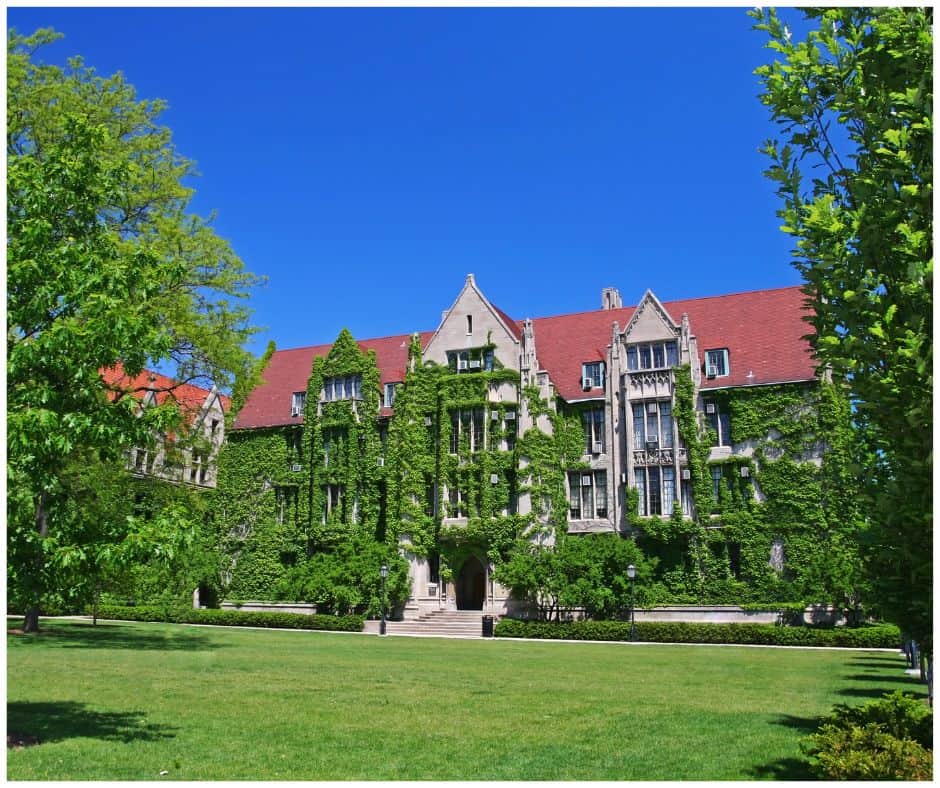Updated on June 24th, 2024
When college students need to cover the cost associated with getting their degree, many assume that student loans are always part of financial aid packages.
While many schools do include loans as a means of paying for their programs, there are also no loan colleges that have a no loans policy, meeting 100% financial need entirely student loan-free.
This means your student can get their degree without student loan payments or loans being part of the financial aid package, allowing them to cover their expenses without accruing school-related debt. If your student is interested in exploring these options, here’s what you need to know.
If you and your student want to learn more about scholarships, attend our free college scholarship webinar! Head to https://thescholarshipsystem.com/freewebinar to sign up
Contents
Defining Financial Need
Financial need is the difference between the expected family contribution (EFC) calculation on your student’s Free Application for Federal Student Aid (FAFSA) and the cost of attendance. The FAFSA takes information about your student’s and family’s financial situation and calculates the expected family contribution as what it deems is an affordable amount for your student to cover tuition on their own.
Typically, the FAFSA reviews your household income, savings, specific investments, and similar financial factors to decide how much your student or family is expected to contribute to their education.
The exact amount of the EFC varies (at times dramatically) depending on your own family’s income and unique circumstances. If your student has completed their FAFSA, the information on the assigned EFC is part of the result. If your student hasn’t finished the FAFSA, you can get an estimate using this handy calculator.
Your student’s financial need to borrow money to attend college, is determined by subtracting their EFC from the cost of attendance.
As an example, if your student’s EFC is $10,000, and the cost of an undergraduate student attending college for a year is $30,000, that makes your student’s financial need $20,000.
HOW NO LOAN POLICY COLLEGES WORK
At many schools, your student’s financial aid package will cover their remaining need through a combination of grants, scholarships, work-study options, and/or student loans, depending on the results of their FAFSA and other factors. However, at no loan colleges, student loans aren’t part of the package.
Instead, no loan schools only offer grants, scholarships, and work-study opportunities to cover the costs beyond your student’s EFC.
Using the example from above, this means your student’s financial aid will be completely loan-free while still handling the $20,000 in financial need if they focus solely on no-loan policy colleges.
Now, many no-loan colleges only ensure that student loans aren’t required to cover a student’s financial need, as demonstrated financial need is defined by the student’s EFC. Colleges that meet 100% financial need without federal loans have no control over the EFC (the remaining $10,000 from the example); that is entirely in your student’s or family’s hands. Further, some only function as no-loan colleges for lower-income households. If your family’s income is above the income threshold above, student loans may be part of the package.
Additionally, work-study is a common requirement in these programs. This means your student will be working part-time in exchange for the school covering their tuition. But work-study can be a great opportunity, as most colleges strive to ensure that the work your student takes on is relevant to their future career, making it a powerful experience and resume builder.
WHAT MOTIVATES NO LOAN COLLEGES?
It isn’t uncommon to wonder why a school would want to ensure that students can still pay tuition and cover their financial need without student loan or student debt either. However, the colleges do have a big incentive to be no loan colleges.
First, it gives them the ability to attract the best and brightest students, regardless of their and their family’s financial situation. It makes high-cost schools more competitive in the eyes of lower-income students because their higher education will be seen as more affordable.
Second, no loan schools may have an easier time when it comes to crafting a diverse student body. Since they are prepared to help students cover the remaining costs beyond the EFC without loans, they can have “need-blind” admissions, eliminating financial considerations from the admissions process.
No loan colleges can provide equal access to a high-quality education, bridging the gap between students that come from low- and high-income households.
HOW CAN NO LOAN SCHOOLS AFFORD IT?
In the vast majority of cases, no loan policy colleges that meet 100% financial need are predominately supported by endowments and gift aid. Endowments are a combination of donations and investment assets that help the school generate income.
Student financial aid administrators play a crucial role in managing these endowments and ensuring that the financial aid packages meet the needs of students without requiring loans.
At times, wealthy families help off-set the cost and financial burden of offering these programs to undergraduate students. If a household can reasonably afford to pay for all of their undergraduate student’s tuition, they may have to do so, ensuring that low-income students can have access to additional aid.
Complete List of No Loan Colleges
The schools that offer these programs can vary from one year to the next. Additionally, the income requirements can shift, allowing the colleges to focus on providing loan-free options to students who may otherwise be unable to afford to attend their school
However, certain colleges have a long-standing history of offering such opportunities to a large portion of their students:
- Amherst College
- Berea College
- Bowdoin College
- Brown University
- Colby College
- College of the Ozarks
- Columbia University
- Grinnell College
- Davidson College
- Harvard University
- Johns Hopkins University
- Northwestern University
- Pomona College
- Princeton University
- Smith College
- Stanford University
- Swarthmore College
- University of Chicago
- University of Pennsylvania
- Vanderbilt University
- Washington & Lee
- Yale University
Other schools use their family income limits when determining who qualifies for loan-free options, including:
- Bryn Mawr College
- California Institute of Technology
- Connecticut College
- Cornell University
- Dartmouth University
- Duke University
- Emory University
- Haverford College
- Lafayette College
- Lehigh University
- Massachusetts Institute of Technology (MIT)
- Oberlin College
- Rice University
- Tufts
- University of North Carolina
- University of Virginia
- Vassar College
- Washington University
- Wellesley College
- Wesleyan University
- Williams College
In some cases, no-loan options are only available to first-year and transfer students. Others may focus their no-loan programs on specific majors or programs or limit it to only the first four years a student attends college.
Additionally, a range of states (including, but not limited to, Arizona, California, Maryland, Michigan, Texas, and Washington) also offer no student loan programs to low-income, in-state residents on a school-by-school basis.
Ultimately, your student will need to review details about the school’s financial aid program to see what may be available, as each school can handle the situation differently, and the financial aid options may vary from one academic year to the next.
OTHER WAYS TO MEET 100% FINANCIAL NEED WITHOUT STUDENT LOANS
While the schools above may be an option for your student, there are other ways to cover the tuition costs without private student loans, and even potentially avoid student loans when covering EFC.
Your student needs to complete their FAFSA every year, ideally as soon as applications are being accepted for the next school year. This may increase their chances of getting grants and other forms of loan-free student aid, especially since some are awarded on a first-come, first-serve basis.
Scholarships are also an important source of funds, particularly if your student has an EFC. It is entirely possible to earn enough in scholarships to pay for an entire college education, making financial aid packages essentially irrelevant.
If your student wants to cover their college costs with scholarships, they need to apply to as many as possible and focus on turning in applications all year-round. This increases their odds of being selected, helping them off-set their EFC or even completely cover their college expenses.
If you and your student want to learn more about scholarships, attend our free college scholarship webinar! Head to https://thescholarshipsystem.com/freewebinar to sign up
Getting a part-time job or paid internship can also be an excellent option, especially if your student isn’t offered any work-study opportunities. While the idea of juggling employment and school can be daunting at first, many students find it perfectly manageable once they get into the swing of things. Plus, they can earn real experience, which may help them land a better job after they graduate.
By examining all of their options for no-loan college now, your student can avoid student loans, allowing them to leave college with their degree in hand, graduating debt free and without any student loan debt.








Leave a Reply